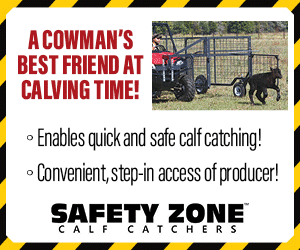The best time to start controlling these pests is before you see the first one
By Rhonda McCurry
Photos by Malloree Barnes
douglas.ensley@boehringer-ingelheim.com
Just like anything related to raising cattle, the time is now to treat for the summer’s most annoying ranch problem – flies.
Fly control is a sensitive effort. It takes the right product in the right amount at the right time to make a difference. Most ranchers fit fly control into an already-planned day of working cattle but to get the most bang for their buck, there is a strategy to help eliminate flies the best way possible.
The details come from Douglas Ensley, DVM and technical marketing manager for cattle with Boehringer Ingelheim. Ensley works to ensure the company’s products are marketed in the right season and the right way to be effective. He says when it comes to fly control, working with your veterinarian to develop a plan, and getting treatment started prior to the beginning of fly season is the first, best step.
“Once you start seeing flies you are behind the 8-ball,” he says. “Flies reproduce so prolifically that once you’re behind it’s hard to catch up. The first priority is to start treatment early with the right products.”
Timing is also important in terms of geographic region. The peak of fly season varies between the West Coast, Plains, southern and eastern states so Dr. Ensley says the best strategy here is to ask your local veterinarian or county Extension agent about the local trend for peak fly season in the area. Iif you plan to utilize a fly control mineral it is important to begin feeding it before the fly population gets too high to stay ahead of the flies.
If possible, Dr. Ensley recommends implementing a second fly control strategy. Whether it is tags, injection, pour- on or rubs, the second round of treatment should be given 30 days prior to the peak of fly pests in the summer.
In Kansas, Dr. Ensley’s native state, in an ideal fly control program, he would put cows on a mineral fly-control product in mid-March. Peak fly season in Kansas is typically late July so he would bring cows in and put fly tags in their ears at that time. One of the key things Dr. Ensley also puts in place is removal of all fly tags in September, no matter what.
“The amount of chemical on tags diminishes over time and will be gone eventually,” Ensley says. “When you leave the tag in all winter you are giving the flies that exist late in the season a chance to develop resistance to the chemical in that tag.”
Though there are other expenses related to raising cattle, if flies are the biggest burden a rancher really needs to implement a two-treatment regimen. Early on, give one form of treatment, which could be mineral or pour-on that is specific to fly control. Then by late summer the rancher has knocked down the initial threat and can focus on new flies with a second round of treatment, which could be tags or a new variety of pour-on or rub.
“Due to the prolific nature of the fly, we’ve got to keep ahead of that and keep their numbers fairly low,” Dr. Ensley shares. “It helps to be aware of that.”
Dr. Ensley now lives and works in Duluth, Georgia. The regimen in the southeast is the same as his Kansas friends, but slightly different weeks and months of the year. He recognizes that most fly treatments are accomplished during the days cattlemen are already working cows and calves and pushing them through the chute. Though treatment is awfully convenient at this time it may be the wrong dates to truly run an effective fly treatment protocol.
Starting too early with certain products is not cost effective. In Georgia, if you planned to use a fly control mineral he would start with mineral in early February, a time when the temperatures are still moderate, to get ahead of new flies.
There are some types of cattle that are not prone to some fly management techniques. Feedlot cattle producers in most instances aren’t going to use fly tags. They will most likely use misters, sprays and pour-ons as the strategy of choice to keep the fly population down in a feeder situation. It’s also critical to dose the right amount. Few ranchers take time to weigh each cow before running them through the chute and could end up slightly off when eyeballing the cow’s weight instead. If you have a scale, the best option is to dose each animal to its weight, but if a scale is not available Ensley says he would determine the heaviest cow then dose others based on her. Underdosing, he says, will build product resistance faster than overdosing.
Application of the product must also be done right. If you plan to use a backrubber, fog, pour-on, or spray then follow the label directions. Dr. Ensley says, an example would be if you are using a spray, most labels say to make them wet. Look at the product label for weather timing too, as some pour-ons can be applied a mere six hours before rainfall while others might say the animal can get wet. Be careful giving cows and calves pond access after treatment too.
Pink eye strategy and other tips
Working with Extension staff or veterinarians also means they can speak to which type of fly to protect against. Horn or face flies are the most common cattle pests but if pinkeye is a local problem those industry experts can encourage ranchers the right way, before it’s too late.
“Doing fly control can reduce pinkeye problems too,” Dr. Ensley says. “There are good vaccines that do a good job against the primary pinkeye bacteria. But pinkeye is also controlled with good pasture and fly management.”
Bulls, Dr. Ensley cautions, tend to be more susceptible to fly and pinkeye problems than cows. Due to the bull’s responsibility the male’s immunity is typically down so he might require three treatments during the season, two of which might be prior to and during the peak of fly populations.
And remember, when a package of fly tags is opened to throw the unused tags away at the end of the season. They may be less effective in the spring and having the chemical exposed means current flies will work to develop resistance to that product, making it totally obsolete the following spring. With that same reasoning in mind, after cutting out all fly tags in September make sure to properly dispose of them where they won’t come in contact with flies.
It is important to remember if you use a product that is intended for internal and external parasite control then fly control is not recommended. When you use these types of products in this manner you are also impacting the internal parasites. Each time you use the product you may be increasing your risk of developing resistance to the internal parasites. Then when you need internal parasite control your treatment may not be as effective. Also, what some producers do is reduce the dose on these products for fly control and this speeds resistance in internal parasites faster, thereby reducing the benefits. So, when treating for flies use a product that is labeled for fly control, and this will maintain the efficacy of your dewormers. Trying to save that money initially will only cost more to manage flies and other parasites in the end.
Another concern is starting fly treatment too late or too early. Again, Dr. Ensley says working with vets and Extension staff in the home area means being keyed into insect trends and regional pest issues, versus just working from a national calendar.
The main points of controlling flies are timing, dosage and repeat treatments. Don’t give flies a chance to build resistance to products by not changing out fly tags or leaving cut-outs on the ground. Give bulls one more round of treatment above cows and calves. Work with a veterinarian or local expert to get a feel for the types of flies and their peak season.
“Just like herbicide resistance in wheat, flies do the same thing,” Dr. Ensley concludes. “Chemical kills only those parasites or pests that are susceptible to the drug. Anything that lives is resistant to the drug.”




